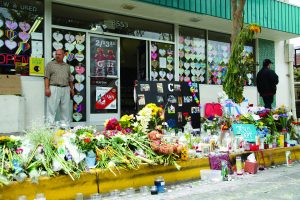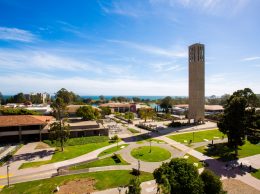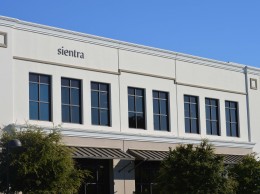
Sam Hassan, owner of Isla Vista Deli Mart, stands before a memorial for Christopher Martinez, a UCSB student who was shot dead inside the store during the May 23 shooting last year. Five other UCSB students were also killed, along with the shooter. (File Photo)
A year after the murder of six UC Santa Barbara students shook the beachside community of Isla Vista, residents grapple with public safety issues while a bill providing the community of 20,000 with a quasi-independent governing body sits in the California state legislature.
Just about 2 square miles wide and situated alongside the UCSB campus, Isla Vista is an unincorporated area of Santa Barbara County with a population dominated by college students, and a history of public safety issues.
Now a bill titled AB-3 would create a seven-person governing body, establish a utility tax and provide other changes such as regulated parking and the ability to contract for more public safety services.
A native of Isla Vista and a UCSB graduate himself, State Assembly member Das Williams authored the bill after meeting with students, UCSB officials and other members of the community expressing the need for local revenue and oversight to ensure public safety.
“As the population of Isla Vista has grown, the number of officers on the street has either remained stagnant or gone down,” Williams said, adding that the area is in need of basics like adequate lighting. The bill also seeks to regulate parking and establish a rental housing mediation task force to resolve issues between landlords and tenants.
“Many of the low-income families are tenants so having a rental housing mediation task force — which the city of Santa Barbara has but Isla Vista doesn’t — is really important,” Williams said.
A bill to create a so-called community services district received approval from the Assembly’s Local Governance Committee in mid-May and has been endorsed by the Santa Barbara County Board of Supervisors and city of Goleta. Meanwhile, local landowners and the Santa Barbara County Local Agency Formation Commission, or LAFCO, have been doubtful of the ability of a special district to provide Isla Vista with what it needs.
Chuck Eckert, director of the Santa Barbara Rental Properties Association, is one Isla Vista property owner who questions whether a special district is the right way forward. He said the proposal was not presented to the Santa Barbara County Local Agency Formation Commission as it should’ve been, but instead proposed directly by Williams as a legislative initiative.
“They think it’s a good idea so they’re going to just bypass the ideas given by LAFCO,” he said, adding that there’s potential for additional property taxes to be placed on landowners in the future since the legislation does not provide protection against such a possibility. “It contemplates taxation without representation.”
But the key problem with the current proposal, Eckert said, is its lack of board representation for property owners who do not reside in Isla Vista.
“I think it ought to have a governing board that includes representatives of everybody affected by it — everybody’s that going to be paying taxes,” Eckert said. “This proposal for a CSD doesn’t do that.”
The bill would create a seven-person board with five elected members who must be residents of Isla Vista as well as two other appointed members — one from the county and one from UCSB.
While UCSB has not endorsed the legislation, the university’s board of trustees made informal recommendations to Chancellor Henry Yang in support and have played a key role in garnering the support of public officials to push the bill forward. When Williams first proposed AB-3, Santa Barbara County Supervisor Doreen Farr testified in support of the bill in Sacramento.
“Given the demographics of the population of Isla Vista, having appointed seats will provide some much needed stability to the board,” Farr told the legislature.
With a population density of about 12,376 people per square mile, Isla Vista’s median annual income for families was reported to be about $26,250, according to 2000 U.S. census data, and students make up more than half the population.
“The county and the university provide multiple services to the community and giving them representation on the board will help ensure the continued investment into Isla Vista while providing a platform to hear directly from the community,” Farr told the legislature.
George Thurlow, executive director and assistant vice chancellor of alumni affairs at UCSB, has assisted the Chancellor’s Coordinating Committee on Isla Vista and said the university is making both financial and administrative efforts to improve public safety measures in the community.
“UCSB continues to be committed to improving safety efforts in Isla Vista, and we’ve been making long-term investments in IV with significant amounts of money,” said Thurlow. In a memo issued by UCSB’s Chancellor Yang in March, Yang said the university has invested millions into providing basics like lighting and having enough patrol officers on duty.
“Over the past decade alone, the university has invested tens of millions of dollars in resources, including at least $2 million annually that the university provides for public safety,” Yang wrote in the memo. “Recently, the university also contributed $220,000 to help fund additional street lighting and sidewalks projects.”
Yang said the university has also received a $570,000 grant from the U.S. Department of Education that will go toward health and wellness counseling on campus and in Isla Vista, and the university has added a $2 million fund to its Long Range Development Plan to be matched by the county to fund local safety and infrastructure improvement projects.
The tragic murder of six UCSB students, coupled with riots last April resulting in hundreds of arrests and a string of violent sexual assaults in the months prior as well as a decade-long history of students dying from cliff falls created a storm of public outcry and what many saw as a need for change.
One UCSB graduate who helped spearhead efforts to have Williams propose the bill, Jonathan Abboud, said the timing was ripe to provide governance in Isla Vista that was long needed and long ignored.
“A lot of attention was focused on IV, from the county and the university,” Abboud said. “They wanted to help, so this was maybe the only chance to get them to help with permanent, lasting difference in IV. Because the county and university’s support of IV comes and goes through the years.”
In 2001, a LAFCO staff report recommended excluding Isla Vista from being incorporated into the city of Goleta due to differences in “community identity” between the two.
“Many residents of the Goleta Valley perceive I.V. as a separate community, whether it really is or not. The sense that students are there implies a lot less permanent residents in the area,” LAFCO staff executive officer Bob Braitman then told the UCSB campus paper, the Daily Nexus. “The theme we found in all the comments we received is that people were concerned that a transient population will be more inclined to vote for bond issues because they won’t be paying for those bonds in the future.”






 Print
Print Email
Email

















